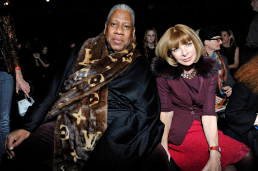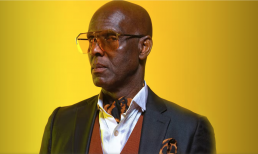Communications
Marketing Lessons From The Fashion Industry
Marketing Lessons From The Fashion Industry
To me, the greatest marketers are fashion icons. And by fashion icons I don’t mean supermodels or the best dressed celebrities. I mean the ordinary individuals who put in captivating work that suddenly makes them seem extraordinary. Some of my top fashion icons are André Leon Talley, former editor-at-large of Vogue magazine; Dapper Dan, the underground creative genius that bootlegged luxury fashion to pimps and gangstas; Diana Vreeland, who worked as a columnist and editor of Harper’s Bazaar and later served as the editor-in-chief of Vogue magazine, and finally Anna Wintour, the private and mysterious British Journalist who has served as editor-in-Chief of Vogue since 1988, and Global Chief Content Officer for Condé Nast since 2020.
I study the work and follow the moves of these four individuals because I believe their subject matter knowledge is endless, obsessive passion is contagious, thinking is insanely divergent, product appreciation is deep, and the rebellious attitude to getting their work done is alluring to me. These five variables are the essential ingredients that are consistent across each individual’s profile, and I believe makes them extra-ordinary. Fashion or not, they are extremely savvy marketers of concepts and products who I believe can sell anything as long as they are interested in it or care about it enough. It’s like what Jay-Z said in ‘Dirt Off Your Shoulder’ – “I’m the realest that run it, I just happen to rap”.
So, these are incredible humans, but why are they great marketers? First factor we will explore is Vanity. As you know, the fashion world has been criticised for being unreal and vain. People in the industry supposedly act as if fashion is the true religion (pun intended), and nothing else exists – and I wonder why that is so wrong. If you don’t believe so much in the work that you do, how do you expect to make someone else believe in it? If Steve Jobs did not have a blinding belief in interface and experience design, would he have been able to convince others to become advocates enough to make Apple attain the status of the world’s most valuable company? I think not.
Anna Wintour is considered the most powerful woman in the global fashion industry, and I’m not even sure she’s ever sewed a stitch of fabric. Fashion designers treat her like the Queen of England and consumers are constantly trying to demystify her. But what makes Anna so powerful, is not only the mystery that lurks behind her dark shades and wicked bobs, it is that she captains Condé Nast – the ultimate lifestyle brand conglomerate, and a melting pot of vanity – which is a guaranteed marketing machine that sells out anything and anyone.
Next factor to look at will be Personality. Everyone that was or is a leading voice in the fashion industry, is an absolute original. From physical appearances to personal idiosyncrasies, the four aforementioned people are very authentic and unapologetic about how they carry themselves and how they are perceived. This comes across authentically in their personal branding which makes them absolute magnets to their various tribes. It makes connecting with their audiences easier, and it makes persuasion and conversion easier. While reading Dapper Dan’s memoir aptly titled ‘Made in Harlem’ – I noted an interesting story he told about touring Africa and ending up in Senegal, where the bulk of his money was spent buying beautiful fabrics which tailors made into nice suits for him. This almost got him stranded in Africa by the way. Dap likes to look fly, and one thing that is consistent about him and all the other fashion icons I follow, is the compulsive need to cultivate and appreciate style.
Another important factor is Showmanship. If you skim through fashion history; study roll-out plans, exhibitions, and sustaining conversations to drive sales and talkability, you’d note that fashion is highly histrionic. Fashion designers and some fashion editors are the greatest showmen. They know how to put on a show or magazine that makes everyone stop, point and talk. To me, Diana Vreeland still remains the only fashion editor who understood the charm of the human pose, the soul of an outfit, the personality of a typeface, and the architecture of a brilliant layout. She was the master of detail and exaggeration – and she embodied these two elements completely. Checkout her documentary ‘Diana Vreeland: The Eye Has to Travel’ whenever you can.
The final factor that makes fashion icons marketing geniuses is Sustenance. They understand the art of sustaining conversations long after exhibitions are over. The phrase ‘paint a picture with words’ was probably originally used to describe André Leon Talley. His deep love for style, taste and character, merged with his vast knowledge of the fashion industry helped him connect with fashion designers on a purely artistic level. This enabled him to tell the stories of their personality and collections long after the last model had left the runway.
Nostalgia Is One Hell Of A Drug
Nostalgia Is One Hell Of A Drug
Cambridge English Dictionary defines nostalgia as “a feeling of pleasure and sometimes slight sadness at the same time as you think about things that happened in the past”. I define nostalgia as a sensation or perception as it relates to culturally shared moments across age groups, ethnicities, race, profession and academic school of thought. Nostalgia as an element of social consciousness, is polarizing by nature. This means that two cultural groups will not remember the same event the same way, either one group has positive emotions, and the other group has negative emotions, or both groups hold varying degrees of positive and negative emotions.
Kareem “Biggs” Burke, an esteemed pop-culture philosopher once said “sometimes I miss the vibe, but then I remember the disrespect”, I hope I quoted that correctly. What this statement literally does is to further illustrate the polarizing nature of nostalgia even within the group or the individual. Think about it, have you ever reminisced about an old horror movie that you saw as a kid with your family, and in the same breath remembered the crippling fear you felt when the night came and the lights went out? Or a uni lover who did you dirty but in spite of that holds a warm place in your heart even though you still get PTSD from the heartbreak? – why would an experience that ended badly, continue to feel so good?
Well, we have our brains to thank for that. By design, the brain functions to elevate parts of the memory which are pleasurable, and represses the parts which are unpleasant. It is a complicated process of human evolution that has served the human race from time. Does this mean that our brain is broken? No, all it does is what it has been designed to do – plug, play, optimize. Part of optimization is memory decay, our conscious and subconscious memories are filed away in the unconscious – this is the deepest and darkest parts of our minds. Memories that get filed away in the unconscious cannot be actively recalled no matter how hard you try, what helps are retrieval cues, or in more extreme cases, hypnosis.
Retrieval cues are basically elements in the environment that triggers recall. Retrieval cues can be present in the external environment, such as sound, smell, touch, taste, and sights. Retrieval cues can also be internal to the person retrieving the memory, such as physical states or feelings. Retrieval cues are why Usher has a hit song titled “You Remind Me” – retrieval cues are why a familiar perfume scent can either make you smile ear to ear, or tear up a little in memory of the one that got away. Retrieval cues are so powerful, and it is why the design universe has informally decided to adopt certain colors as symbolic representation of actions. The red light means stop and so does your delete button, even if you’ve not read the words on the button, you automatically recognise what it could 90% mean.
Retrieval cues are all around us, it’s in the music we listen to, the movies we watch, the billboards we see, the magazines we read, the market we patronize, the documentaries we learn from, the digital ads that bombard us, and the people we are drawn to interact with. These different social elements tap into a moment in the time of our lives that will form the relatability needed to buy into their agenda. Advertisers, movie/music directors, interaction designers, salesmen, PR consultants, image architects etc, are intentionally or unintentionally adept at using retrieval cues to sell a story through visuals and words, that will trigger the action needed to make a sale or change perception for good.
Polarizing in nature as it is, the powerful allure of nostalgia has clearly proven to be leaning favorably towards pleasant memories. For communicators, this means that in developing strategies, tactics, and eventual comms tool kits, it is important that you stay within cultural familiarity – do your research into the words, images, and storylines that helps your audience form stronger cultural associations with your products. For designers, who I refer to as the magicians who speak the language of the unconscious memory, the task is to use shapes, colors, layouts and typefaces as visual collaterals that introduces the brand personality and strengthens its positioning as a trusted friend and cultural ally.
As internet penetration spreads across the planet, more people are adopting the use of smart mobile phones, and the world continues in its move into digital-first platforms of interactions. This means that there will be an influx of culturally diverse pockets of people, and there’s a need for robust integrated communication strategies that incorporates and projects an authentic cultural salad bowl that not only taps into the culture, but represents moments in the culture. In designing products for finance, entertainment, health, wellbeing and sports, ask yourself – beyond the technicalities and business strategies, what’s the one thing the user will remember about my product? How do I immortalise the concept?
Why You Should Care About The Fashion Industry
Why You Should Care About The Fashion Industry
Do you ever wonder why people love to hate the fashion industry? I mean I love it, but I cannot speak for the rest of you. What I love about fashion is not even the industry, and as much as I’d like, it is not the style, beauty and glamour. What truly draws my attention to the fashion industry is the image it contributes to, the characterization of the personality at a time in history (in the case of fast fashion), or of all time (in the case of more classic apparels).
People talk a lot about the zeitgeist – which is basically the defining spirit or mood of a particular period of history as shown by the ideas and beliefs of the time. I believe fashion is the zeitgeist, fashion is the mood, and fashion is the emotion. Fashion is one of the most underrated elements of a social structure. People assume because it is just clothes and accessories, then it must be vain – whereas fashion is the backbone of a lot of ‘serious’ societal institutions.
Think of uniformed workers – policemen, pilots, doctors, nurses, soldiers, traffic wardens. When we look at them, we automatically perceive them as figures of authority, in a way, their image alters our behaviour, simply because of the symbolism the clothing represents. Take the same people out of the uniform and they become just any regular Joe. The different uniforms have different styles and a certain kind of beauty attached to their structure, color theme and texture. But ultimately, it is the image that the uniform evokes, that is more powerful.
Fashion is beyond the runway. Let me explain what that means. If you google the word ‘Fashion’ right now, there are two definitions you will find, the first is; Fashion – ‘a popular or the latest style of clothing, hair, decoration, or behaviour’, the second is; Fashion – ‘a manner of doing something’. In this article, I’m exploring what the second means in the context of identity, personality, style, perception, communication and culture.
Simply put, if society was broken down like the anatomy of a human, fashion will be the blood. The first time I understood the depth and reach of the fashion ecosystem – I was hanging out with my Landlord in Opebi, Lagos on a Sunday evening. He paints interesting works of art and has some degrees in Art History. He explained how fashion is literally the material element in the definition of culture (for context, culture is defined as the material and immaterial elements of any society). Think of any time in history, what do you remember it by? – the clothes, the make-up, the accessories, the styles, basically.
We criticise Nollywood and Hollywood for this constantly – “Oh this movie is set in the 70s? Why is her makeup that way? That was not the shoes of the 70s”. We determine time in history by the things we place the least emphasis on; cloth structure, shoes, bags, pieces of jewelry, makeup, slang, wig type, even scents.
At this point, if you’ve seen ‘Devil Wears Prada’ – you’d remember the scene where Meryl Streep schooled Anne Hathaway about how her dismissive opinions about fashion was totally unwarranted, because the scrumpy sweater Anne had on, was determined through the ‘frivolous’ activities that she thought were inconsequential.
Fashion is the most authentic expression of self, expression is art, art is history, and history determines the perception of a society. Fashion has certainly been my backbone. It reminds me of who exactly I think I am when my insecurities are doing a madness. It has also been a long journey to figuring out what my style is, because I have found out that not everything I admire will look good on my body structure.
Everyone that wants to be successful in life needs to go through the process of figuring out what their style is. It sounds so banal and unnecessary but trust me, dedicating the time to understand what works for you and makes you feel like your ideal self will totally change your life. You will feel more confident and certain. Study the feel of the types of textiles that make you feel at home, e.g. as much as I like jeans, it does not work for me at all, I have discovered that I feel more at home in soft and free textiles, makes me feel loved and appreciated.
Study colors, study prints, study cloth structures, study cuts – download Pinterest, feed the algorithm, and it will help you. You will know what you like, don’t shrink yourself to fit in, do mood boards of your unique selections, and invest some money into bringing them to life. No matter how imperfect or insecure you feel, this exercise will make you whole – you will feel worthy, worthy of opportunities, worthy of trying out, worthy by being enough, worthy by feeling enough, worth that can only be gotten from physically wearing clothes.
Why Thinking Outside The Box Is NOT What You Think It Is
Why Thinking Outside The Box Is NOT What You Think It Is
I remember sitting in my first brainstorming session as a Communications Intern 8 years ago, when the account handler encouraged us to think outside the box and present a big idea to communicate the client’s business objectives. Like Professor X, I went deep into my mental faculties, I thought long and hard, I read Comms case studies, I thought some more, and came up with nothing. It really baffled me, how did I come up with nothing? Does this mean I’m dumb?
I have since developed as a Senior Consultant in my current profession and I have been part of several brainstorming sessions. I have also worked with some of the biggest brands in Nigeria and delivered several high level campaigns. The singular summation of my experience in delivering campaign strategies has been this – the most obvious solutions are the ones hardest to come by because of the self-imposed cultural constraints we work within.
‘Thinking outside the box’ what does that even mean? What is the box? How do you think outside of it? Simply put, the ‘box’ is the subculture we exist in as individuals in the society, and thinking outside of it means intentionally experiencing other subcultures that helps us see our challenges from a different perspective and help us get it. For the layman, subcultures are anything with a process or unique way of doing things – could mean industries, religion, professions, ethnic groups, social class, schools, fashion houses, animal groups, or even mechanical things like cars, blenders, hair dryers and so on. It’s basically anything that has an influence on our perspective.
The most important thing to understand about this statement of innovation heuristic is that ‘thinking outside the box’ is not really so much about your intelligent quotient (IQ), but your emotional quotient (EQ). ‘Thinking outside the box’ is also not about how much time you dedicate to thinking about it. Think about the statement ‘outside the box’ as a Venn diagram – your solution lies at the center of your experiences, and two other unique experiences. Now, depending on the challenge you are trying to solve or the sector you play in, your EQ will help determine what differing experiences are worth simulating or which unique experts to sit with in order to crack the case.
If you’ve seen Mad Men, you’d recall that the opening scene of the legendary advertising series illustrates exactly what I outlined in the preceding paragraph. Don Draper, creative director of the fictional Manhattan advertising firm, Sterling Cooper, is trying to solve an advertising challenge for Lucky Strike – a cigarette company, one of his agency’s top accounts. He is shown asking the busboy attending to him why he smokes a competition’s cigarette brand and the waiter provided a simple answer that refocused Don’s perception and helped him solve his challenge. Mind you, this scene was set in 1960 America when segregation was at its peak. Don is a young and accomplished white man, talking to an older black man who has nothing in common with the people he is trying to sell to, yet uttered the words that were key to a major insight for Sterling Cooper.
To illustrate further, if as a non-smoking Product Manager, I have been commissioned to lead a product development process for a smoking app, the mental model I am working with is limited because I do not possess knowledge of a smoker’s motivation, behavioural processes and incentives of the smoking experience. The reasonable thing to do in that case will be to covertly study the smoker by living their subcultural experience – get familiar with smokers at different stages of the habit, hangout where smokers hangout, talk to the sales people for cigarette brands, and talk to researchers of cigarette brands. By the time you are done, you would have a holistic perspective to the product user that will inform the interaction and brand design strategies that will make your product successful. This is why method acting exists, but that’s an aside.
I will end this article with the ancient story of a group of blind men who had never come across an elephant before. They learned and imagined what the elephant was like by touching it. The first person, whose hand landed on the trunk described it as a snake, another described its ear as a kind of fan, another described its leg as a tree-trunk. The blind man who placed his hand upon its side said the elephant is a wall. Another who felt its tail, described it as a rope. The last felt its tusk, stating the elephant is that which is hard, smooth and like a spear.
Each blind man failed in their description as a result of limited experiences. As process managers, business men, builders, and consultants, we are all blind men. Ultimately, whoever succeeds in solving innovative challenges is the person who has experienced the full picture. You should strive to be the blind man who touches all parts of the elephant. It takes time, but you will win, eventually, and the win is usually long-term.




